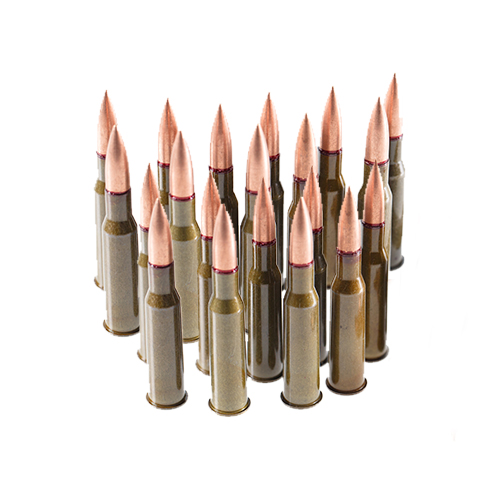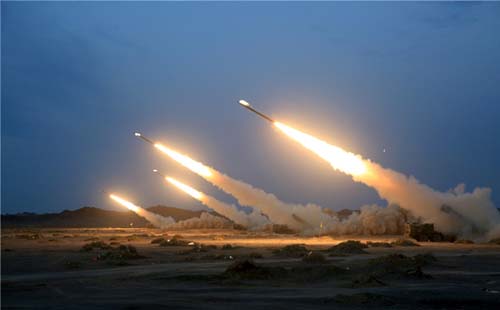AMMUNITION
Information about ammunition

Direct fire Ammunition
Direct fire ammunition is designed to work with weapons which launch a projectile directly at a target within the line-of-sight. The firing weapon must have a sighting device and an unobstructed view to the target, which means no obstruction, including friendly units, can be between it and the target. Direct fire weaponary leaves both itself and its user open to return fire.
Infantry ammunition
Most common types of ammunition, usually used by military and other peace keeping units (police, security forces).
Conventional ammunition in production and deployment consists of:
- 5.56 mm, 7.62 mm, 9 mm, 10 and 12gauge, .22 caliber, .30 caliber, .38 caliber, .45 caliber, .300 Winchester Magnum (WinMag)
- .50 caliber and 12,7x108mm ammunition for Heavy machine guns.
- Speacial 14,5x114mm ammunition for Russian design KPVT Heavy machine gun.
- Ammunition for infantry postable anti-tank launchers (RPG-7, RPG-9, etc.)
Autocannon ammunition
Ammunition deesigned to be used with fully automatic, rapid-fire projectile weapons that fires armour-piercing and/or explosive shells.
They are usually vehicle-mounted, aircraft-mounted, or boat-mounted, or even remote-operated as in some applications.
They can use a variety of ammunition: common shells include high-explosive dual-purpose types (HEDP), any variety of armour-piercing (AP) types, such as composite rigid (APCR) or discarding sabot types (APDS).
- 23mm Autocannons – 23x152mmB for ZU-23; 23x115mm for GSh-23
- 30mm Autocannons – 30x165mm for 2A42, 2A72 and CZ-30
Tank ammunition
Tactical tank ammunition consists of unique cartridges designed to fight with enemy heavy srmor units.
Each kind is designed to defeat one or more specific threat targets.
The family includes among others Kinetic Energy (KE), High-Explosive (HE), Shaped charge HEAT (High-Explosive Anti-Tank) for:
- 100mm for T-54/55 cannons
- 125mm for 2A46 cannons
- 105mm NATO L7 cannons
- 120mm NATO L/55 cannons
Grenades
A grenade is an explosive weapon typically thrown by hand, but can also refer to projectiles shot out of grenade launchers.
Generally, a grenade consists of an explosive charge, a detonating mechanism, and firing pin inside the grenade to trigger the detonating mechanism.
- Hand thrown infantry granades fragmentation (FRAG), high explosive (HE), concussion and smoke grenades.
- Ammunition for infantry postable anti-tank launchers (RPG-7, RPG-9, etc.).
- VOG type grenades for Russian type grenade launchers and automatic grenade launchers.
- NATO standard grenades for AGLs (CIS-40) or Under-barrel grenade launchers (M203).
Indirect Fire Ammunition
Indirect fire ammunition is especially designed for firing a projectile without relying on a direct line-of-sight between the gun and its target. Aiming is performed by calculating azimuth and inclination, and may include correcting aim by observing the fall of shot and calculating new angles. It is most commonly associated with field artillery (Howitzers or Rocket Artilery) and mortars.
Howitzer ammunition
This kind of ammunition reliers on payload-carrying projectile (shell) that contains an explosive or other filling (illumination charges, smoke, incendiary, etc.)
- 105mm ammunition – HE-FRAG intended for light field howitzers
- 122mm ammunition – HE-FRAG, HEAT, Smoke or Illuminating
- 152mm ammunition – HE-FRAG, HEAT, Smoke or Illuminating
- 155mm ammunition – HE-FRAG, HEAT, Smoke or Illuminating
Rocket ammunition
Ammunition for artillery which utilizes rockets as a projectile (RM-70, BM-21 GRAD, etc.).
The rocket ammunition is intended for massive salvo fire covering selected area with high density saturation fire to effectively suppres and destroy enemy possitions.
- 122mm JROF – standard 20km, High explosive fragmentation rocket
- 122mm G-2000 – extended 40km range, High explosive fragmentation rocket
Mortar ammunition
Thanks to the their shorter-range (compared to howitzer artillery), and excellent and more effective for tactical field operations. In particular, due to its high, parabolic trajectory with a near vertical descent, the mortar can land bombs on nearby targets, including those behind obstacles or in fortifications, such as light vehicles behind hills or structures, or infantry in trenches.
- 60mm Commando mortar bombs – HEI (High-Explosive Incendiary), HEF (High-Explosive Fragmentation), 60mm SMK (smoke screen) or 60mm ILL (area illumination)
- 60mm standard mortar bombs – High-Explosive (HE), Smoke or Illumination (ILL)
- 81/82mm mortar bombs – High-Explosive (HE), Smoke or Illumination (ILL)
- 120mm heavy mortar bombs – High-Explosive (HE), Smoke or Illumination (ILL)


Direct fire Ammunition
Direct fire ammunition is designed to work with weapons which launch a projectile directly at a target within the line-of-sight. The firing weapon must have a sighting device and an unobstructed view to the target, which means no obstruction, including friendly units, can be between it and the target. Direct fire weaponary leaves both itself and its user open to return fire.
Infantry ammunition
Most common types of ammunition, usually used by military and other peace keeping units (police, security forces).
Conventional ammunition in production and deployment consists of:
- 5.56 mm, 7.62 mm, 9 mm, 10 and 12gauge, .22 caliber, .30 caliber, .38 caliber, .45 caliber, .300 Winchester Magnum (WinMag)
- .50 caliber and 12,7x108mm ammunition for Heavy machine guns.
- Speacial 14,5x114mm ammunition for Russian design KPVT Heavy machine gun.
- Ammunition for infantry postable anti-tank launchers (RPG-7, RPG-9, etc.)
Autocannon ammunition
Ammunition deesigned to be used with fully automatic, rapid-fire projectile weapons that fires armour-piercing and/or explosive shells.
They are usually vehicle-mounted, aircraft-mounted, or boat-mounted, or even remote-operated as in some applications.
They can use a variety of ammunition: common shells include high-explosive dual-purpose types (HEDP), any variety of armour-piercing (AP) types, such as composite rigid (APCR) or discarding sabot types (APDS).
- 23mm Autocannons – 23x152mmB for ZU-23; 23x115mm for GSh-23
- 30mm Autocannons – 30x165mm for 2A42, 2A72 and CZ-30
Tank ammunition
Tactical tank ammunition consists of unique cartridges designed to fight with enemy heavy srmor units.
Each kind is designed to defeat one or more specific threat targets.
The family includes among others Kinetic Energy (KE), High-Explosive (HE), Shaped charge HEAT (High-Explosive Anti-Tank) for:
- 100mm for T-54/55 cannons
- 125mm for 2A46 cannons
- 105mm NATO L7 cannons
- 120mm NATO L/55 cannons
Grenades
A grenade is an explosive weapon typically thrown by hand, but can also refer to projectiles shot out of grenade launchers.
Generally, a grenade consists of an explosive charge, a detonating mechanism, and firing pin inside the grenade to trigger the detonating mechanism.
- Hand thrown infantry granades fragmentation (FRAG), high explosive (HE), concussion and smoke grenades.
- Ammunition for infantry postable anti-tank launchers (RPG-7, RPG-9, etc.).
- VOG type grenades for Russian type grenade launchers and automatic grenade launchers.
- NATO standard grenades for AGLs (CIS-40) or Under-barrel grenade launchers (M203).

Indirect Fire Ammunition
Indirect fire ammunition is especially designed for firing a projectile without relying on a direct line-of-sight between the gun and its target. Aiming is performed by calculating azimuth and inclination, and may include correcting aim by observing the fall of shot and calculating new angles. It is most commonly associated with field artillery (Howitzers or Rocket Artilery) and mortars.
Howitzer ammunition
This kind of ammunition reliers on payload-carrying projectile (shell) that contains an explosive or other filling (illumination charges, smoke, incendiary, etc.)
- 105mm ammunition – HE-FRAG intended for light field howitzers
- 122mm ammunition – HE-FRAG, HEAT, Smoke or Illuminating
- 152mm ammunition – HE-FRAG, HEAT, Smoke or Illuminating
- 155mm ammunition – HE-FRAG, HEAT, Smoke or Illuminating
Rocket ammunition
Ammunition for artillery which utilizes rockets as a projectile (RM-70, BM-21 GRAD, etc.).
The rocket ammunition is intended for massive salvo fire covering selected area with high density saturation fire to effectively suppres and destroy enemy possitions.
- 122mm JROF – standard 20km, High explosive fragmentation rocket
- 122mm G-2000 – extended 40km range, High explosive fragmentation rocket
Mortar ammunition
Mortar ammunition is used to provide effective Fire Support (FS) to infantry or mechanized infantry at the platoon and company level.
Thanks to the their shorter-range (compared to howitzer artillery), and excellent and more effective for tactical field operations. In particular, due to its high, parabolic trajectory with a near vertical descent, the mortar can land bombs on nearby targets, including those behind obstacles or in fortifications, such as light vehicles behind hills or structures, or infantry in trenches.
- 60mm Commando mortar bombs – HEI (High-Explosive Incendiary), HEF (High-Explosive Fragmentation), 60mm SMK (smoke screen) or 60mm ILL (area illumination)
- 60mm standard mortar bombs – High-Explosive (HE), Smoke or Illumination (ILL)
- 81/82mm mortar bombs – High-Explosive (HE), Smoke or Illumination (ILL)
- 120mm heavy mortar bombs – High-Explosive (HE), Smoke or Illumination (ILL)
